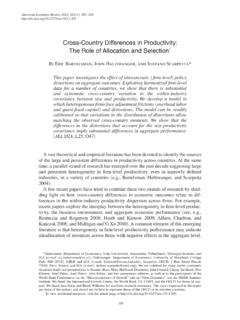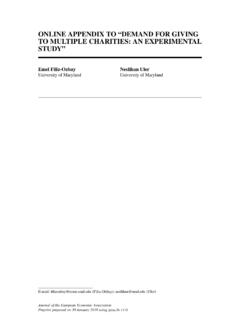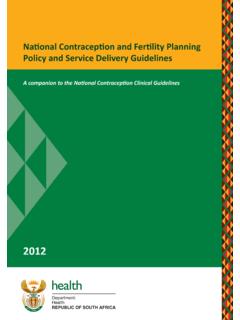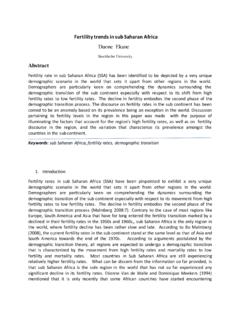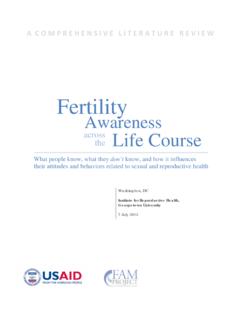Transcription of HIV and fertility in Africa: first evidence from ...
1 J Popul Econ (2013) 26:835 853 DOI PAPERHIV and fertility in africa : first evidencefrom population-based surveysChinhui Juhn Sebnem Kalemli-Ozcan Belgi TuranReceived: 6 May 2011 / Accepted: 25 September 2012 /Published online: 8 December 2012 Springer-Verlag Berlin Heidelberg 2012 AbstractThe historical pattern of the demographic transition suggests thatfertility declines follow mortality declines, followed by a rise in human capitalaccumulation and economic growth. The HIV/AIDS epidemic threatens toreverse this path. We utilize recent rounds of the demographic and healthsurveys that link an individual woman s fertility outcomes to her HIV statusbased on testing. The data allow us to distinguish the effect of own positiveHIV status on fertility (which may be due to lower fecundity and otherphysiological reasons) from the behavioral response to higher mortality risk,as measured by the local community HIV prevalence.
2 We show that althoughHIV-infected women have significantly lower fertility , local community HIVprevalence has no significant effect on noninfected women s editor:Junsen ZhangElectronic supplementary materialThe online version of this article( ) contains supplementary material, which is availableto authorized JuhnDepartment of Economics, University of Houston, Houston,TX 77204-5019, USAC. JuhnNBER, Cambridge, USAS. Kalemli-OzcanDepartment of Economics, University of Maryland, 4118D Tydings Hall,College Park, MD 20742, USAB. Turan (B)Economics Department, Atilim University, Incek-Golbasi,06836, Ankara, Turkeye-mail: Juhn et fertility Economic developmentMathematics Subject Classifications (2010)O12 I12 J131 IntroductionA fiercely debated question in the health and development literature is theimpact of HIV/AIDS epidemic on economic growth.
3 So far, there is no con-sensus. The calibration studies find big effects mainly due to the destruction ofhuman capital (see Corrigan et ). The empirical studies using economicgrowth as an outcome show mixed an influential paper, Young(2005) suggests that population declines will lead to higher capital laborratios and eventually to higher per capita income in the affected postulates that widespread community infection will lower fertility , bothdirectly through a reduction in the willingness to engage in unprotected sex,and indirectly, by increasing the scarcity of labor and the value of women stime. Using household data from south africa and relying on between cohortvariation in country-level HIV infection and number of births, he estimates alarge negative effect of HIV prevalence on fertility .
4 He concludes that evenunder the most pessimistic assumption for human capital destruction, thefertility effect dominates and hence future per capita income of south this paper, we use newly available micro data from population-basedsurveys to examine the fertility response to HIV/AIDS. The question isimportant since we cannot answer the question of the effect of the diseaseon development without knowing the response of fertility to the disease. Inthe latest rounds of the demographic health surveys (DHS), HIV testing wasadministered in 13 African countries allowing us to link an individual woman sdetailed fertility and health history to her own HIV status. One advantage ofthis newly available data is that it provides us with a more accurate estimateof HIV prevalence in the population.
5 Previous researchers, including Young(2005), relied on estimates based on samples of pregnant women attendingprenatal clinics which may have higher or lower prevalence rates relative to amore representative sample. Another advantage of the new data is that wecan examine separately the impact ofownHIV status from the impact of1 Bloom and Mahal (1997) run cross-country regressions of growth of GDP per capita onHIV/AIDS prevalence and find no effect. Papageorgiou C, Stoytcheva P (2008, What Is theImpact of AIDS on Cross-Country Income So Far? evidence from Newly Reported AIDS Cases,unpublished) find negative effect on the level of income per capita in a similar framework. Werker,E D, Ahuja A, Wendell B (2006, Male Circumcision and AIDS: The Macroeconomic Impact of aHealth Crisis, unpublished) instrument HIV/AIDS prevalence by national circumcision rates andshow that there is no effect of the epidemic on growth of the African and Turan (2011) shows that Young s identification from time-series data maynot be appropriate given the existing trends in south African data due to abolition of apartheidand the ongoing demographic and fertility in africa : first evidence from population-based surveys837community-wide prevalence.
6 Women who are HIV positive may have lowerfertility due to physiological reasons, , the disease may lower fecundity orthe individual may be too sick to be sexually active. By examining changes infertility amongnoninfectedwomen, we can focus on the behavioral responseto increased risk of infection and preview our results, we find that the disease significantly lowers aninfected woman s fertility . Being infected with HIV reduces births last yearby approximately 20 25 %, depending on whether we control for maritalstatus. Women who are infected are considerably more likely to be widowed,separated, or divorced, which are marital status categories also associatedwith lower birth ordinary least squares (OLS) estimation assumesthat HIV-positive and HIV-negative women are comparable once we controlobservable characteristics.
7 This assumption may be violated if HIV-positiveand HIV-negative women are systematically different in unobservable it is not possible for us to entirely rule out selection on unobservablesgiven the cross-sectional nature of our data, we examine to what extentunobserved heterogeneity may be driving our results by exploiting fertilityhistories of older women who are currently observed to have positive ornegative HIV status. We find little difference in birth outcomes of HIV-positive and HIV-negative women when we examine their fertility historiesprior to 1986 (before the onset of the disease). This suggests that unobservedheterogeneity is not the major driving force behind our results. We also findsimilarly sized negative impact of HIV when we control for measures of sexualbehavior such as condom use and multiple partners, which suggests that thephysiological impact of the disease may play an important find little evidence , however, of a behavioral response in fertility tomortality risk, as proxied by community-level prevalence rates.
8 In OLS regres-sions, we regress fertility of noninfected women on the local community HIVprevalence rate and find no significant effect. While our standard errors arelarge, we can nevertheless rule out the large negative fertility responses foundin Young (2005). We also use earlier surveys to build community-level paneldata. Assuming zero prevalence of the disease before 1986, we run communityfixed effects regressions and find no significant effects. Our community-levelresults are consistent with Fortson (2009) who also uses fertility histories andperforms a variety of robustness checks in examining the relationship betweenHIV and fertility . While the methodology and the results on community-levelHIV rates are similar across the two papers, we also examine in this paper theeffect of own HIV status on fertility which we believe is of interest in its HIV-positive women, 29 % are widowed, separated, or divorced as opposed to 7 %among HIV-negative community-level results were produced independently and at the same time in an earlierversion of our paper, Juhn C, Kalemli-Ozcan S, Turan B (2008) HIV and fertility in africa : FirstEvidence from Population Based Surveys and a working paper version of Fortson (2009).
9 838C. Juhn et , our estimate of the impact of HIV on total fertility rate is consid-erably smaller than reported in Young (2005). His estimates suggest that acommunity that has 100 % prevalence would have fertility that is approxi-mately 80 % lower than a community with zero prevalence. Our estimate ofthe impact of HIV, working exclusively through the own effect, suggests thatfertility would be approximately 20 % lower. Given that country-level preva-lence rates fall well below 100 %, this translates into relatively small reductionsin country-specific total fertility rates. For example, even in Lesotho, whichhas the highest prevalence rate in our sample ( %), the total fertility ratewould be children, higher (approximately 4 8 %) in the absence paper proceeds as follows.
10 Section2lays out the conceptual the data. Section4presents the empirical results. Section5examines the impact of HIV on total fertility rates, and Section6concludesour Conceptual frameworkTo begin, we can turn to the large theoretical literature that links life ex-pectancy and economic development. Neoclassical growth models identifytwo effects. The first -order effect of increased life expectancy is to increasepopulation. When there is no behavioral response in fertility , reductions inmortality increase population, thus reduce capital labor and land labor ratiosand depress per capita income. This effect is offset to some degree if increasedlife expectancy, and more generally, better health, raises TFP and the rateof human capital accumulation. Models in the tradition of Becker and Barro(1988) that endogenize fertility show that fertility may respond to reinforcethis latter effect towards higher investment and growth (see, for example,(Cervelatti M, Sunde U (2007) Human Capital, Mortality, and fertility : AUnified Theory of Economic and Demographic Transition, unpublished),Tamura (2006), Soares (2005), Kalemli-Ozcan (2003), Galor and Weil (2000),Lucas (2000), and Ehrlich and Lui (1991)).
